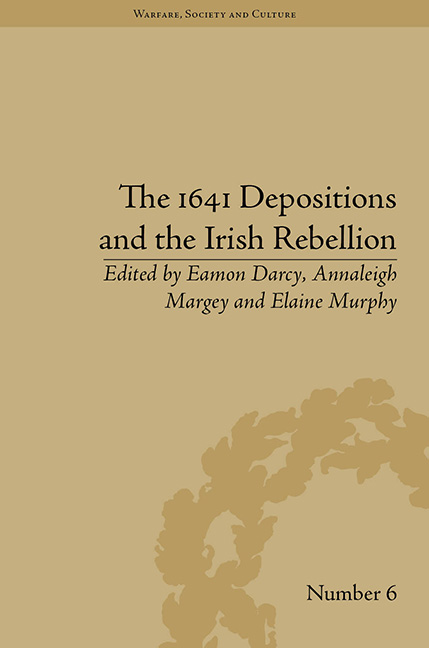Book contents
- Frontmatter
- CONTENTS
- Dedication
- Acknowledgements
- List of Contributors
- List of Figures and Tables
- List of Abbreviations
- Preface
- Introduction
- Part I The Outbreak of the Rebellion
- Part II Social Aspects of the Rebellion
- 5 ‘In Monies and Other Requisites’: The 1641 Depositions and the Social Role of Credit in Early Seventeenth-Century Ireland
- 6 1641 and the Ulster Plantation Towns
- 7 The Social Order of the 1641 Rebellion
- 8 ‘Rogues, Villaines & Base Trulls’: Constructing the ‘Other’ in the 1641 Depositions
- Part III Political and Military Aspects of the Rebellion
- Conclusion: The Rebellion in Text and Context
- Notes
- Index
8 - ‘Rogues, Villaines & Base Trulls’: Constructing the ‘Other’ in the 1641 Depositions
from Part II - Social Aspects of the Rebellion
- Frontmatter
- CONTENTS
- Dedication
- Acknowledgements
- List of Contributors
- List of Figures and Tables
- List of Abbreviations
- Preface
- Introduction
- Part I The Outbreak of the Rebellion
- Part II Social Aspects of the Rebellion
- 5 ‘In Monies and Other Requisites’: The 1641 Depositions and the Social Role of Credit in Early Seventeenth-Century Ireland
- 6 1641 and the Ulster Plantation Towns
- 7 The Social Order of the 1641 Rebellion
- 8 ‘Rogues, Villaines & Base Trulls’: Constructing the ‘Other’ in the 1641 Depositions
- Part III Political and Military Aspects of the Rebellion
- Conclusion: The Rebellion in Text and Context
- Notes
- Index
Summary
Existing research into the role of language in constructing out-group and in-group identities during periods of conflict or unrest consists overwhelmingly of examinations of media and political discourses of the twentieth and twenty-first centuries, encompassing legitimation during the Second World War, post-war anti-Semitism, justification of nuclear weapons during the Cold War, representations of Muslims following the attacks of September 2001, representations of the enemy during the second Gulf war, and representations of immigrants and refugees in various contexts. Yet the manipulation of language to create differential constructions of social groups, and to justify particular courses of political or military action, is by no means a uniquely twentieth century phenomenon. A recent study by Prentice and Hardie presents one of the few discourse analytical examinations of seventeenth-century conflict texts, focusing on media representations of participants in the Glencairn uprising in Scotland in 1653. Their analysis reveals a number of ways in which contrasting discourses were drawn upon to describe the opposing sides of the conflict, with the ‘self ’ – that is the English and their allies – portrayed as honourable, fair and loyal, while the ‘other’ – Glencairn and the Scottish forces – were subject to a negative semantic prosody, associating them with criminality, violence and untrustworthiness. Representations of participants in the events of the 1641 uprising have until recently received little attention from discourse analysts, but this formed a novel aspect of the Arts and Humanities Research Council (AHRC) funded project ‘Language and Linguistic Evidence in the 1641 Depositions’ at the University of Aberdeen. With a background in modern-day forensic discourse analysis and a particular interest in language and representations of violence in legal and investigative contexts, my role was to interrogate the depositions from this unexplored perspective. A particular interest has always been the influence of institutional representatives – for example, police officers – on the accounts that emerge from their encounters with laypeople. In this essay I focus on demonstrating how a corpus-assisted discourse analysis can provide robust evidence for the existence of particular patterns of representation of groups of actors in the depositions.
- Type
- Chapter
- Information
- The 1641 Depositions and the Irish Rebellion , pp. 113 - 128Publisher: Pickering & ChattoFirst published in: 2014



